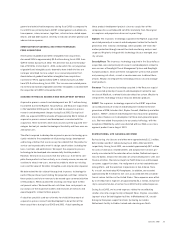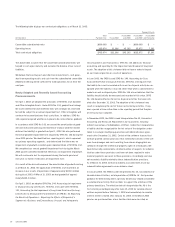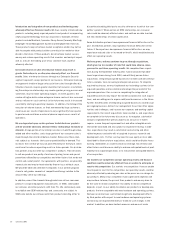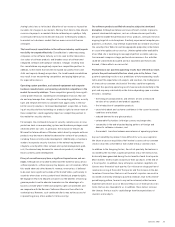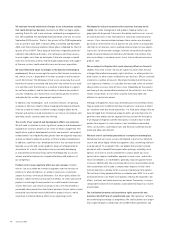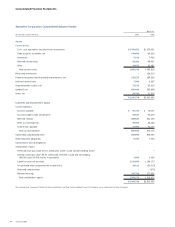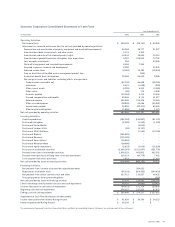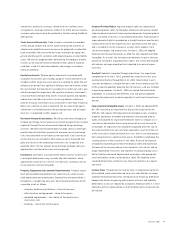Symantec 2003 Annual Report Download - page 41
Download and view the complete annual report
Please find page 41 of the 2003 Symantec annual report below. You can navigate through the pages in the report by either clicking on the pages listed below, or by using the keyword search tool below to find specific information within the annual report.
Symantec 2003 39
strategic decisions as to the best allocation of our resources to position
ourselves for changes in our markets. We may from time to time allocate
resources to projects or markets that do not develop as rapidly or fully
as we expect. We may fail to allocate resources to third party products,
to markets or to business models that are more successful than we
anticipate.
The trend toward consolidation in the software industry could impede
our ability to compete effectively. Consolidation is underway among
companies in the software industry as firms seek to offer more exten-
sive suites of software products and broader arrays of software and
integrated software and hardware solutions. Changes resulting from
this consolidation may negatively impact our competitive position. In
addition, to the extent that we seek to expand our product lines and
skills and capacity through acquisitions, the trend toward consolidation
may result in our encountering competition, and paying higher prices,
for acquired businesses.
Operating system providers, and network equipment and computer
hardware manufacturers are becoming substantial competitors in the
market for security solutions. These competitors generally have signifi-
cantly greater financial, marketing or technological resources than we
do, and may leverage their strengths at the computing platform, security
layer and network tier levels to compete more aggressively in the mar-
ket for security solutions. Continued development, acquisition, or licens-
ing of security solutions technology or products rights by one or more of
these competitors could negatively impact our competitive position in
the market for security solutions.
For example, the continued inclusion of security, remote access or virus
protection tools in new operating systems and hardware packages could
adversely affect our sales. In particular, the inclusion of features by
Microsoft in future editions of Windows which directly compete with our
products may decrease or delay the demand for certain of our products,
including those currently under development. Additionally, as hardware
vendors incorporate security functions in the network equipment or
integrate security within their network and system management prod-
ucts, the demand may decrease for some of our products, including
those currently under development.
Piracy of our software may have a significant impact on our net rev-
enues. Although we are unable to determine the extent of piracy of our
software products, software piracy may depress our net revenues. While
this would adversely affect domestic revenue, revenue loss is believed
to be even more significant outside of the United States, particularly in
countries where laws are less protective of intellectual property rights.
We engage in efforts to educate consumers on the benefits of licensing
genuine products and to educate lawmakers on the advantages of a
business climate where intellectual property rights are protected, and
we cooperate with the Business Software Alliance in their efforts to
combat piracy. However, such continued efforts may not be successful
in preventing piracy of our products from occurring.
Our software products and Web site may be subject to intentional
disruption. Although we believe we have sufficient controls in place to
prevent intentional disruptions, such as software viruses specifically
designed to impede the performance of our products, we expect to be an
ongoing target of such disruptions. Similarly, experienced computer pro-
grammers, or hackers, may attempt to penetrate our network security or
the security of our Web site and misappropriate proprietary information
or cause interruptions of our services. Uninterrupted online availability
of our Web site is becoming increasingly important as online subscrip-
tion renewals comprise a larger portion of our revenues. Our activities
could be substantially disrupted, and our reputation and future sales
harmed, if these efforts are successful.
Fluctuations in our quarterly operating results have affected our stock
price in the past and could affect our stock price in the future. If our
quarterly operating results or our predictions of future operating results
fail to meet the expectations of analysts and investors, the trading price
of shares of our common stock and of the notes could be negatively
affected. Our quarterly operating results have varied substantially in the
past and may vary substantially in the future depending upon a number
of factors, including:
•the timing of announcements and releases of new or enhanced
versions of our products and product upgrades;
•the introduction of competitive products;
•uncertainty about and customer confidence in the current economic
conditions and outlook;
•reduced demand for any given product;
•unfavorable fluctuations in foreign currency exchange rates;
•seasonality in the end-of-period buying patterns of foreign and
domestic software customers; and
•the market’s transition between new releases of operating systems.
Any such volatility may make it more difficult for us to raise capital in
the future or pursue acquisitions that involve issuances of our common
stock or securities convertible or exercisable into our common stock.
In addition to the foregoing factors, the risk of quarterly fluctuations is
increased by the fact that a significant portion of our net revenues has
historically been generated during the last month of each fiscal quarter.
Most resellers tend to make a majority of their purchases at the end of
a fiscal quarter. In addition, many enterprise customers negotiate site
licenses near the end of each quarter. Our reliance on a large portion of
revenue occurring at the end of the quarter and the increase in the dol-
lar value of transactions that occur at the end of a quarter can result in
increased uncertainty relating to quarterly revenues. Due to this end-of-
period buying pattern, forecasts may not be achieved, either because
expected sales do not occur or because they occur at lower prices or on
terms that are less favorable to us. In addition, these factors increase
the chances that our results could diverge from the expectations of
investors and analysts.






